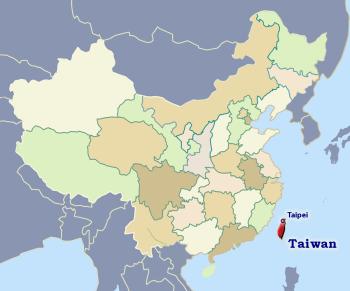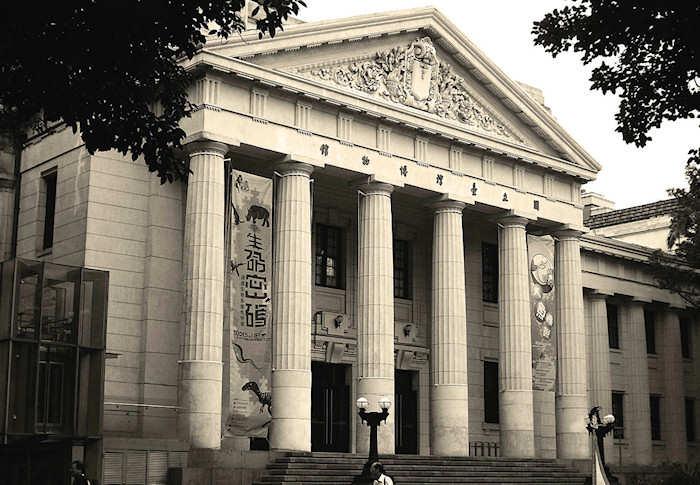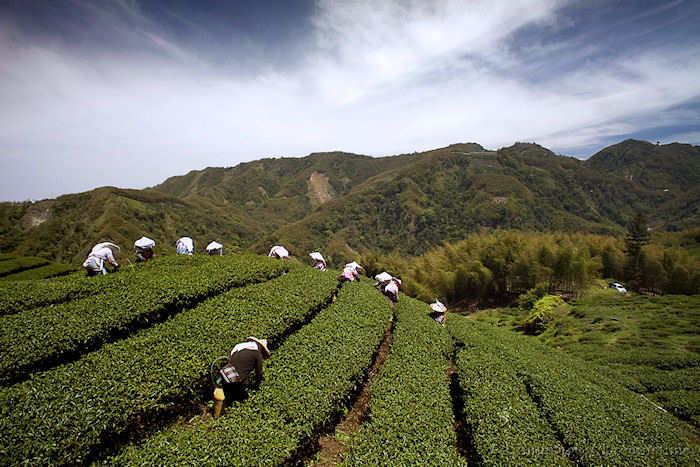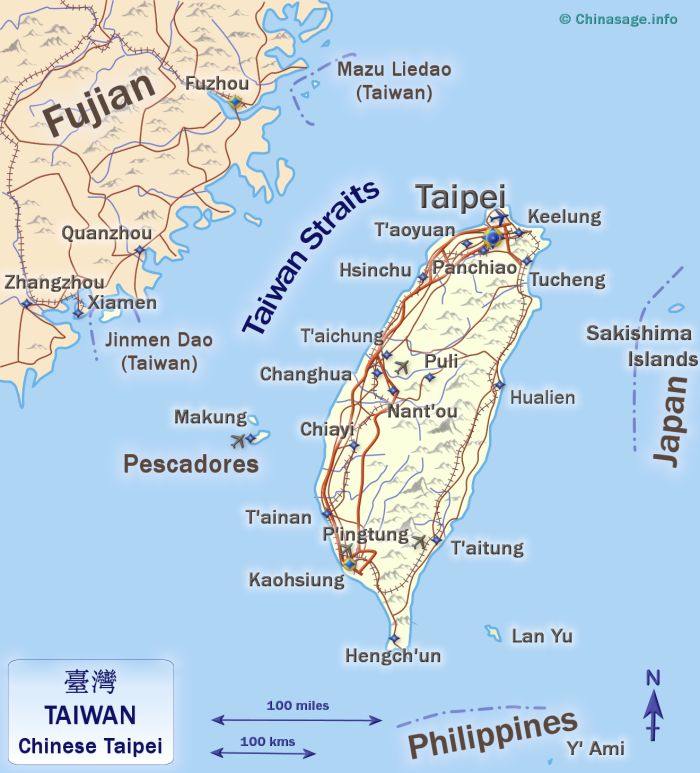Taiwan (Chinese Taipei)

| Name | Táiwān 台湾 |
| Capital | Taipei |
| Population | 23.2 million |
| Area | 36,000 km2 |
| GDP | 19,888 |
Relations between the island of Taiwan and mainland China have been of great importance for the past 75 years. With tensions gradually easing due to increased trade and tourism there is hope that the armed conflict that long threatened has been avoided. The name Taiwan is the 'western' name that is most often used overseas. Like most names for things Chinese this is not quite correct. The term Chinese Taipei is now often used as the official name; it represents a bit of a compromise between the two sides.
Taiwan is slightly larger in area than the state of Maryland ➚ or Wales ➚ and is densely populated (about 23.2 million people, compared to 1413 million in mainland China). It lies just 100 miles [161 kms] miles off the coast of south east China and within one hundred miles of both Japan and the Philippines. It has a mountainous interior and a subtropical climate. The mountains slope down to the west and the western fringe has the best agricultural land. In summer frequent typhoons sweep in from the Pacific over the island. The capital of the island of Taiwan is the city of Taipei.

History of Taiwan
The early history of Taiwan is one of repeated conquest. The bare facts can be briefly stated. Prior to Dutch conquest in 1624 it was in the hands of its indigenous people who were fiercely independent of Chinese rule. It was the Portuguese who in 1554 gave the island its alternative name ‘Formosa’ (meaning ‘beautiful island’) and this name was used in the West up to 1945. The Dutch spice traders conquered it as another island in their chain of trading posts. Over time, the name which the Dutch used for their port of ‘Tayouan’ became ‘Taiwan’, and this was then used in the west for the island as a whole.
When the Ming dynasty fell to the Manchus in 1644, a leading Ming military leader (Guoxingye Koxinga WG) held out longest. In 1659 he lost the Battle of Nanjing ➚ fleeing to Kinmen (Quemoy) and then finally to Taiwan. He ejected the Dutch settlers who had begun to colonize in 1623. Attacks from Qing ships gradually wore down Guoxingye's resistance and the Manchus eventually took over the island in 1683 adding Taiwan to the Qing Empire.
Taiwan remained a province of China for two hundred years and a great many people from Fujian province settled there. For a time, France, as part of building its Indo-Chinese Empire invaded both Taiwan and Vietnam. Following defeat at the battle of Lang Son ➚ France gave up its control of Taiwan at the Treaty of Tianjin 1885 ➚. The island was then seceded to Japan as a result of the terms of the peace treaty that ended the Sino-Japanese War (1894-95) together with the Liaodong peninsula. Taiwan was ruled by Japan for the next 50 years and used as a strategic base during the Second World War. During the Japanese occupation the island was relatively peaceful and was rapidly modernized with many Chinese adapting to Japanese customs. The island became more prosperous and the success must have led Japan to believe that its subsequent conquest of the mainland would be largely trouble-free.
During Chiang Kaishek's negotiations with Stalin, Churchill and Roosevelt in the early Second World War (1943) the claim that Taiwan, once the Japanese had been defeated, was to become an integral part of China became established; before that Taiwan was considered a separate entity.
Civil War bolt-hole
Taiwan became a political hot potato at the end of the Chinese Civil War (1927-1950) between the Communists and Nationalists (Guomindang or Kuomindang WG). When Mao founded the People’s Republic of China in 1949, the defeated Nationalist leader Chiang Kaishek fled to Taiwan. It was the potential rekindling of the Civil War and the possible re-conquest of China by the Nationalists (or conquest of Taiwan by China) that kept the dispute rumbling on.
The Nationalists had no natural claim to Taiwan when they invaded the island in 1945 after the withdrawal of the Japanese. Chiang brought with him $300 million in gold; silver and foreign currency to the island together with the best army divisions (2,000,000 men) and many art treasures. There was a revolt by the Taiwanese in 1947 against Guomindang rule which was brutally suppressed by General Chen Yi (the February 28th incident ➚). With the start of the Korean War in 1950, America intervened to defend Taiwan from attack by the PRC. Chiang Kaishek ruled Taiwan as well as a number of small islands dotted along the coast of Fujian and Zhejiang provinces. In the period 1954 to 1958 the Communist PLA sought to capture the islands (the Battle of Yijiangshan Islands ➚). The Nationalists with massive American aid fended off attacks at Kinmen (Quemoy). Indeed the United States threatened to use nuclear weapons ➚ against China if Kinmen was attacked - despite the fact that China did not have an atomic bomb to defend itself at this time. In an awkward compromise the Nationalists gave up the Dachen islands but kept control of Matsu and Kinmen. So there remains the slightly unreal capability of viewing ‘foreign territory’ within easy sight of mainland China. No wonder the relationship with Taiwan is so fraught.
Throughout the ensuing Cold War between the super powers Chiang Kaishek gambled that a US-Soviet War was likely, and that would bring him huge American military support to drive out the Soviet supported Communists. He calculated that this eventuality would sweep him back to power from his ‘temporary’ island fortress of Taiwan. It is estimated that the Americans spent $2 billion supporting Chiang, much of which was embezzled. US military support included training and transport and during the Korean War ➚ the US Navy set up a base in Taiwan.
Like so many events in Chinese history there are echoes of earlier times, when the Ming dynasty fell to the Manchus in 1644, Guoxingye (Koxinga WG) led attempts from his Taiwan stronghold to re-conquer China and re-establish the Ming dynasty. Such parallels do not go unnoticed in Beijing or Taipei.

American Support for Taiwan
The continued American support for Nationalists led to another great injustice. Despite China's great size in both area and population, she had to wait eleven years before being given a seat at the United Nations ➚. When the UN was founded in 1945 the Republic of China (Nationalists) were quite naturally chosen as the representatives of China, and despite their defeat and exile to Taiwan, America blocked any change to their status. It was not until October 25, 1971 that the United Nations recognized the Communist Beijing regime (People's Republic of China) as the representatives of the Chinese People (USA was one of 35 nations still opposed to their admission). Now the tables have turned, it was China that blocked Taiwan holding a seat at the United Nations in 2007 on the basis that there is only ‘one China’. You will still hear the term ‘One China policy’ mentioned; it neatly encapsulated the view that either the People's Republic is China or Taiwan is China but it cannot be both. The ‘One China’ policy is also used to prevent the recognition of Taiwan as a separate nation state.
In the period 1970 to 1990 Taiwan became a very successful Asian economy with GDP second only to Japan. There were 30 years of steady economic growth. It was investment from the US that helped build up advanced technological industries. Many goods were stamped with ‘Republic of China’ to note their origin. This experience was not lost on politicians in Beijing, as it proved that rapid development in Asia was possible. Nowadays, this has taken another turn, as it is the wealthy Taiwanese who have poured investment into China.
Chiang Kaishek died in Taiwan in 1975, just a year before his chief adversary Chairman Mao Zedong. He was succeeded as President of the Republic of China by his son Chiang Ching-kuo ➚. Chiang Kaishek wished for his remains to be buried in China but perhaps at last signaling the end of the Nationalist KMT dream of re-taking the mainland they were interred on Taiwan in 2004. His son took Taiwan on a reformist trajectory. Martial Law instigated by Chiang Kaishek continued in Taiwan until 1987, since then there has been a gradual move to democracy with relatively free and fair elections.

Closer Ties with China
The visit by former Nationalist leader Lien Chan ➚ to China in 2005 was a major step forward in normalizing relations with China. The Cross-Strait Economic and Trade Forum ➚ is working hard to improve already strengthening economic ties. An Economic Cooperation Agreement ➚ was signed by both sides in 2010. Now that the Guomindang's presumption as the sole political party was broken by Democratic Progressive Party's Chen Shui-bian eight year term as President, open debate on Taiwan's future has developed. Guomindang's leader Ma Ying-jeou ➚ was re-elected President in January 2012 for a second term. On 11th February 2014 China and Taiwan met for the first time in 65 years in face-to-face talks ➚. At the meeting in Nanjing both sides agreed to hold regular meetings in future; although the meeting was between officials rather than leaders.
However, differences still remain between China and Taiwan. Beijing would like to recover Chinese imperial treasures housed at the National Palace Museum ➚ in Taipei; in a situation a little like Greece and the Elgin marbles ➚. Another point of difference is that Taiwan (as with other Overseas Chinese communities) continues to use the traditional 'full' script for writing rather than the modern simplified form on the mainland. The older Wade Giles romanization is still used for place names rather than the Pinyin form. Some look to apply the Hong Kong ‘one country - two systems’ solution to allow Taiwan to have a level of independence within the PRC. There has been a shift towards Taiwanese nationalism away from dreams of KMT conquest of the mainland. Here and there the title ‘Republic of China’ is being quietly replaced by ‘Chinese Taipei’ (as at the 2024 Paris Olympics). Recent deals with China have greatly increased the number of Chinese tourists visiting the island. Vastly increased personal and trading contacts will hopefully erode the historical grievances and finally bridge the Taiwan straits.
The election of Tsai Ing-wen of the opposition DPP (Democratic Progressive Party) in 2016 has strained relations. President Tsai, the first woman to hold the role, sought for an enlargements of democratic freedoms, especially on LGBT issues. She has continued to argue for friendly relations with the mainland but keeping Taiwan independent. In the 2024 presidential election the result was close with Lai Ching-te receiving 40% of the vote ahead of Hou Yu-ih on 33%. However the DPP lost its legislative majority with KMT receiving one more senator with no overall control by any one party. The consensus of all parties is to emphasize Taiwan's distinctive culture and reject the ‘one country - two systems’ option promoted by Beijing. The vast majority wish to maintain the island's current position of semi-independence.
Places to Visit in Taiwan
The National Palace Museum ➚ in Taipei must surely be high on everyone's list of places to visit in Taipei. It contains many treasures from Imperial China brought here by Chiang Kaishek's nationalists. Nearby are the old mining towns Jinguashi and Jiufen. Away from the busy city are the Beitou hot springs and the volcanic peaks of Yangmingshan National Park ➚.
Most of the modern development is on the west coast: Taichung and Changhua offer much of interest.
The rugged east coast lacks the industrial activity of the west and it is here that you can find the indigenous people and there is a National Park at Taroko ➚ with fine views of the surrounding landscape.
Tainan ➚ at the south of the island has many historic temples and other buildings of interest. Nearby is the Maolin National Scenic area and the Kenting National Park ➚. The Sun and Moon Lake 日月潭 rì yuè tán near Yuchi is the largest lake in Taiwan with fine sights and an isolated Lalu island; the lake is located within the aboriginal tribal area. It gets its name because one part is round like the sun and the other part crescent shaped like the moon.
Kaohsiung ➚ in the far south is the second most important city on the island after Taipei.
Despite military tensions with the mainland the many islands in the Taiwan Straits can be visited. Penghu islands ➚ have fine beaches and unspoilt fishing villages.

Google map of Taiwan
Bing map of Taiwan ➚
Show Bing Map ➚